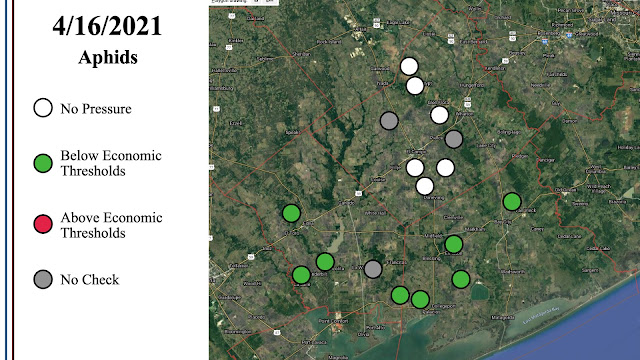Howdy,
We have a bit of replant going on in our area, but most of my fields are looking good. Everything could use a rain, the amount has been varied across our area. Hopefully this weekend everyone will get the rain they need.
 |
| Cotyledon Cotton Kate Crumley |
Cotton stands can be impacted by some of the weather we've had recently, but stands as low as 13,000 to 26,000 plants per acre can still be viable as long as the plants are fairly evenly spaced out, with at least 1 plant per foot of row.
 |
| Tobacco Thrips Kate Crumley |
I have seen very few thrips this year, only a few in all the fields I looked at this week. There have been light aphid numbers in most of the fields I looked at,in Jackson and Matagorda county. There are also a few spider mites in most fields I looked at in Jackson and Matagorda counties, and a few in Wharton county, but all at levels far below the economic threshold. Below are charts with my scouting information for this past week, the week of 4/16/2021. If the locations were not checked, it was due to replanting or the field was added to the scouting program after this weeks scouting was completed.
Thrips are a small (about 1/15") light tan, straw, to brown or black colored insect with a punch and suck type mouthpart and asymmetrical mandibles. They punch a hole with one side, then siphon the juice out with the other. They typically feed on one plant cell at a time, and mach along unching and sucking as they go. The adults are winged, and can travel short distances on their own, or be carried by a breeze for a fair distance. Larvae hide on the underside of the leaves, often close to the leaf veins, as well as in the terminal of the plant. Feeding damage for this insect causes cotton leaves to crinkle and curl, and often looks silvery when examined. Thrips feeding can cause delays in plant maturity, which can lead to yield reduction.

Western Flower Thrips
Kate Crumley
 |
| Thrips Damage Kate Crumley |
The economic threshold for thrips is 1 thrips per true leaf until the 5th true leaf stage. Once the plant reaches this stage, treatment for thrips is rarely justified.
 |
| Cotton Aphid Kate Crumley |
The threshold for cotton aphids is 50 aphids per leaf, and if you see aphid mummies in the field (tan or black dry and unmoving aphids), that's a good thing. Parasitoid wasps lay eggs in the aphids, and the aphid forms a mummy while the wasp larvae is pupating inside. These wasps, lady beetles, and lacewings can knock back aphid populations. Treatment for aphids is rarely justified, but if you do decide to treat for aphids, do not use a pyrethroid. Pyrethroids and organophosphates are broad spectrum, and kill beneficial insects as well as your target insect, but pests like aphids bounce back much quicker than their predators do. Their high reproductive rate will allow their numbers to soar after a broad spectrum insecticide application kills all their predators.
 |
| Aphid Mummies on Cotton Kate Crumley |
Spider mite populations rarely get high enough to treat, as they thrive in drier climates and we tend to be fairly humid. Treatment is justified when spider mites are causing visible defoliation.
 |
| Spider Mites on Cotton Kate Crumley |
Please check out our weekly IPM Audio Updates, the website to sign up to receive those is listed below. If you have any questions feel free to contact me either by email or calling the office. Have a good weekend everyone!
Check out our weekly IPM Audio Updates
Making Replant Decisions in Cotton
Cotton Insect Management Guide
Development and Growth Monitoring of the Cotton Plant




No comments:
Post a Comment